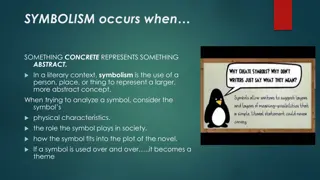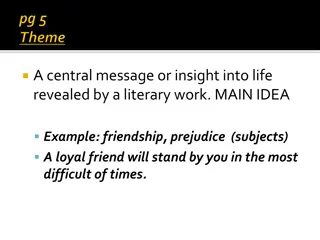Analyzing Themes and Symbolism in Literature
Authors often use symbols to convey themes in their works. This analysis delves into how authors like William Golding in "Lord of the Flies" and Charles Dickens in his novels use symbols, settings, and diction to create mood, highlight societal issues, and develop characters like Pip and Estella. Through these literary devices, the authors bring depth and meaning to their narratives, inviting readers to explore the complexities of human nature and society.
Download Presentation

Please find below an Image/Link to download the presentation.
The content on the website is provided AS IS for your information and personal use only. It may not be sold, licensed, or shared on other websites without obtaining consent from the author.If you encounter any issues during the download, it is possible that the publisher has removed the file from their server.
You are allowed to download the files provided on this website for personal or commercial use, subject to the condition that they are used lawfully. All files are the property of their respective owners.
The content on the website is provided AS IS for your information and personal use only. It may not be sold, licensed, or shared on other websites without obtaining consent from the author.
E N D
Presentation Transcript
A1 Symbols are often used by authors to make a theme.
A1 Symbols are often used by authors to make a theme. The struggle for civilized society has permeated human history for centuries. While countless authors have written fictional accounts of this struggle, William Golding takes a unique three-fold approach in his novel, Lord of the Flies.
A3 The author uses setting to create mood and illuminate the meaning of the work as a whole.
A3 The author uses setting to create mood and illuminate the meaning of the work as a whole. Dickens uses bleak, foreboding settings, such as the churchyard cemetery and Miss Havisham s house, to invoke a spooked dread within the reader. This mood enables the reader to understand Pip s dire circumstances and, in turn, the lower classes of one s own society.
B1 In the poem, a boy is looking at a girl. The author uses diction to show us the relationship of the boy and girl.
B1 In the poem, a boy is looking at a girl. The author uses diction to show us the relationship of the boy and girl. The speaker religious, reverent diction to illustrate that the boy considers the girl perfect and beyond comprehension.
B3 The Satis House is a frightening place for Pip. When Pip is playing cards with Estella, she says, He calls the knaves Jacks, this boy!
B3 The Satis House is a frightening place for Pip. When Pip is playing cards with Estella, she says, He calls the knaves Jacks, this boy! The Satis House is a frightening place for Pip. Pip describes the mansion as dark with no glimpse of daylight to be seen.
B5 Estella is mean to Pip. He calls the knaves Jacks, this boy! This quote shows how mean she is.
B5 Estella is mean to Pip. He calls the knaves Jacks, this boy! This quote shows how mean she is. Estella calls Pips hands coarse and ridicules his common habits when she says, He calls the knaves Jacks, this boy!
B7 These symbols help the reader understand the theme.
B7 These symbols help the reader understand the theme. The destruction of the conch upon Piggy s death illustrates Golding s belief that without logic and intelligence, law and order have no power.
C1 In conclusion, Dickens uses setting to make the mood.
C1 In conclusion, Dickens uses setting to make the mood. In conclusion, the dismal, disturbing settings in Great Expectations create an atmosphere of sadness and isolation.
C3 The mood illuminates the theme of money.
C3 The mood illuminates the theme of money. Dickens s intention in creating this mood is to make the reader feel sympathy for Pip. His situations may be over the top, but they point to the extreme difference in the quality of life between the rich and the poor.























